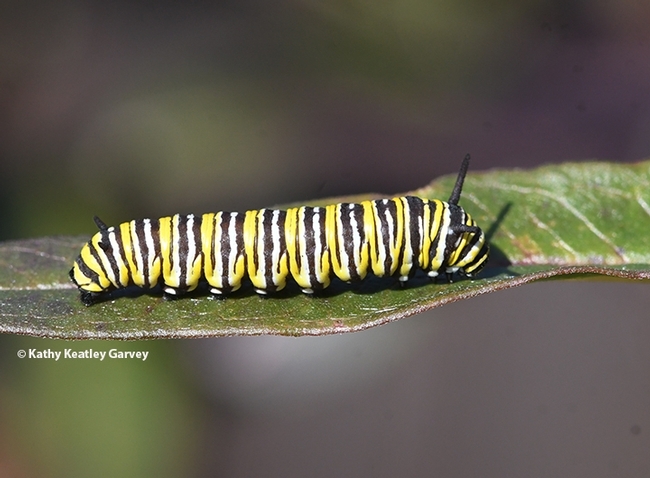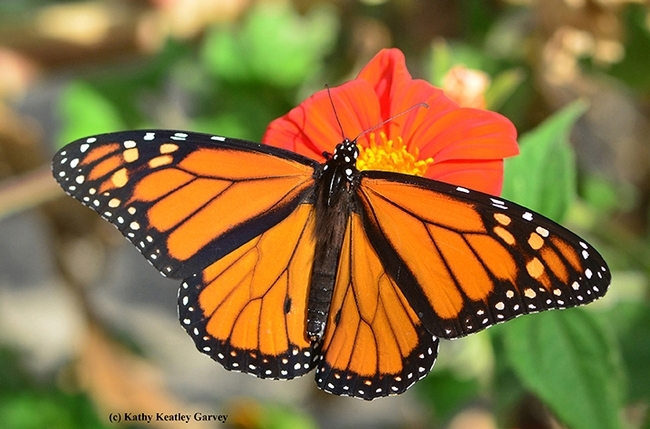
What an incredible story!
It all began with insects and an entomology graduate student's curiosity of how caterpillars turn into butterflies.
Bruce Hammock, now a UC Davis distinguished professor who holds a joint appointment with the Department of Entomology and Nematology and the UC Davis Comprehensive Cancer Center, remembers studying juvenile hormones in the UC Berkeley lab of John Casida back in the 1970s.
He and fellow graduate student Sarjeet Gill, now a UC Riverside distinguished professor emeritus, co-discovered that a key enzyme in the metamorphosis degrades a caterpillar's juvenile hormone, allowing it to move from the larval stage into an adult insect.
So, for the past 50 years, Hammock has been researching inhibitors of soluble epoxide hydrolase or sEH. Those inhibitors alleviate chronic pain and inflammation in experimental animals. That research has led to experimental drugs that target such diseases as diabetes, hypertension (heart disease), Alzheimer's disease, and cancer.
Hammock's curiosity may lead to this: patients suffering from chronic pain and inflammation may be able to take a non-narcotic to alleviate that pain.
Flashback to 2011: Hammock and UC Davis alumna and pharmacologist-toxicologist Cindy McReynolds co-founded EicOsis (pronounced eye-co-sis) in 2011.The Davis-based company recently completed testing a drug candidate in Phase 1 human clinical trials with their lead candidate EC5026 that inhibits sEH. “Inhibiting sEH increases the levels of naturally occurring inflammation resolving and pain-relieving compounds,” Hammock said. “The clinical trial showed no side effects.”
Fast Forward to Today: The company, EicOsis has been named one of Pepperdine Graziadio Business School's 2024 Most Fundable Companies. EicOsis s one of 18 recipients from a competitive pool of more than 2000 U.S. startups and notable in being a pharmacology company. The seventh annual list features companies from diverse sectors, including FinTech, AgTech, Healthcare, Industrial Automation, Consumer Packaged Goods, and Advanced Materials.

“At EicOsis, our mission is to develop new effective and safe oral medicines to help people suffering from pain and inflammation,” said McReynolds. “We are committed to improving the lives of those suffering from pain, helping them feel themselves again.”
EicOsis derives its name from eicosanoid, “the major backbone of chemical mediators in the arachidonate cascade,” said McReynolds. “It symbolizes the epoxide group in chemistry, which is key to the anti-inflammatory chemical mediators and where the biochemical target called soluble epoxide hydrolase works.”
“Chronic pain affects 100 million Americans alone, and the increased prescription of opioids has led to a widespread public health emergency, the U.S. Opioid Crisis,” Hammock said. “Our company seeks to meet the unmet need for safe, non-addictive and effective pain medications that can help pain patients and fight the opioid crisis.”
In the United States alone, more than 81,000 people died of opioid overdose deaths in 2023, according to the Centers for Disease Control, and the National Institutes of Health (NIH), and more than 2.1 million people are addicted. The Helping to End Addiction Long-term Initiative, or NIH HEAL Initiative reports that the opioid epidemic In the 1990s, was "fueled by widespread overprescribing of opioids for pain management. This situation has led to significant reductions in appropriate opioid prescribing for pain at a time when safer and effective pain management strategies are not available to millions of Americans who live with pain.”
EicOsis won the “Sacramento Region Innovator of the Year” in 2019 in the medical health/biopharmaceutical category.
Long and Productive Road. It's been a long but productive road for Hammock, born in Little Rock, Ark., in 1947. Hammock earned a bachelor's degree in entomology magna cum laude, with minors in zoology and chemistry from Louisiana State University in 1969, and his doctorate in entomology/toxicology from UC Berkeley in 1973. A postdoctoral fellowship in biochemistry followed at the Rockefeller Foundation, Department of Biology, Northwestern University, Evanston, Ill.
He also served active duty as a medical officer with U.S. Army Academy of Health Sciences, San Antonio, where he witnessed the depths of acute and chronic pain.
"The frustration of seeing the effects of terrible pain coupled with the inability to effectively treat it has led me on a life-long quest to address pain and related illnesses,” said Hammock. “The study of this enzyme and the natural mediators it regulates has the added benefit of providing deeper understanding of diseases from heart failure to Alzheimer's which in turn is leading to new treatments.”
Since joining the UC Davis faculty in 1980, Hammock has taught a variety of subjects through the years, including biochemistry, endocrinology, toxicology, and pharmaceutical discovery and developmental biology.
As Wikipedia says: "Dr. Hammock continually moves between fundamental research and its application. Amongst his many research endeavors, he found a key hydrolytic enzyme that controlled insect metamorphosis and exploited this by developing transition state inhibitors that altered insect development. Then he used this hydrolytic enzyme in a transgenic viral insecticide. He found another hydrolytic enzyme important in insect development that also controlled key biological functions in mammals. His laboratory developed transition state inhibitors of this enzyme as well, which are used in human clinical trials where they reduce pain and inflammation. In addition, his lab pioneered immunoassay techniques for analyzing both humans and environmental exposure to pesticides and other contaminants. He continues as an internationally recognized figure in these fields for over five decades and has published over 1300 papers."
Highly honored by his peers, Hammock is a fellow of the National Academy of Inventors, which honors academic invention and encourages translations of inventions to benefit society. He is a member of the U.S. National Academy of Sciences, a fellow of the Entomological Society of America, and the recipient of the Bernard B. Brodie Award in Drug Metabolism, sponsored by the America Society for Pharmacology and Experimental Therapeutics. He directed the campuswide NIEHS Superfund Research Program, National Institutes of Health Biotechnology Training Program for almost 40 years and the National Institute of Environmental Health Sciences (NIEHS) Combined Analytical Laboratory.
Cindy McReynolds. “As co-founder, Cindy has played a key role building EicOsis into a leader in therapeutics targeting sEH,” Hammock said in a UC Davis Department of Entomology and Nematology article. "Cindy's scientific insight, drive, and commitment ideally positions her to take EicOsis to the next level and builds on the vast body of science validating our approach. I know Cindy will continue to deliver great results for EicOsis and for a great many patients."
McReynolds received a bachelor's degree (1999) in animal science from UC Davis and a master's degree (2001) in animal science from Washington State University (WSU). Her career advanced from senior research associate, Celera (formerly Axys) in South San Francisco to senior associate scientist of Miikana, Fremont, to project coordinator of Arete Therapeutics, South San Francisco, to UC Davis researcher and EicOsis CEO.
At UC Davis, she served as the scientific program manager (2010-2017) for the Center for Integrative Toxicology, and as a graduate student researcher. She won a UC Davis Staff Assembly Citation of Excellence in Research in 2021. She earlier received the UC Davis 1999 Outstanding Senior Award, and several awards from WSU: the 2000 Dr. Erb Outstanding Graduate Student Award; the 2001 Teaching Assistant of the Year, and the 2001 Outstanding Graduate Student. While a graduate student, she was supported by a National Institutes of Health Chemical Biology Training Grant.
Attached Images:

